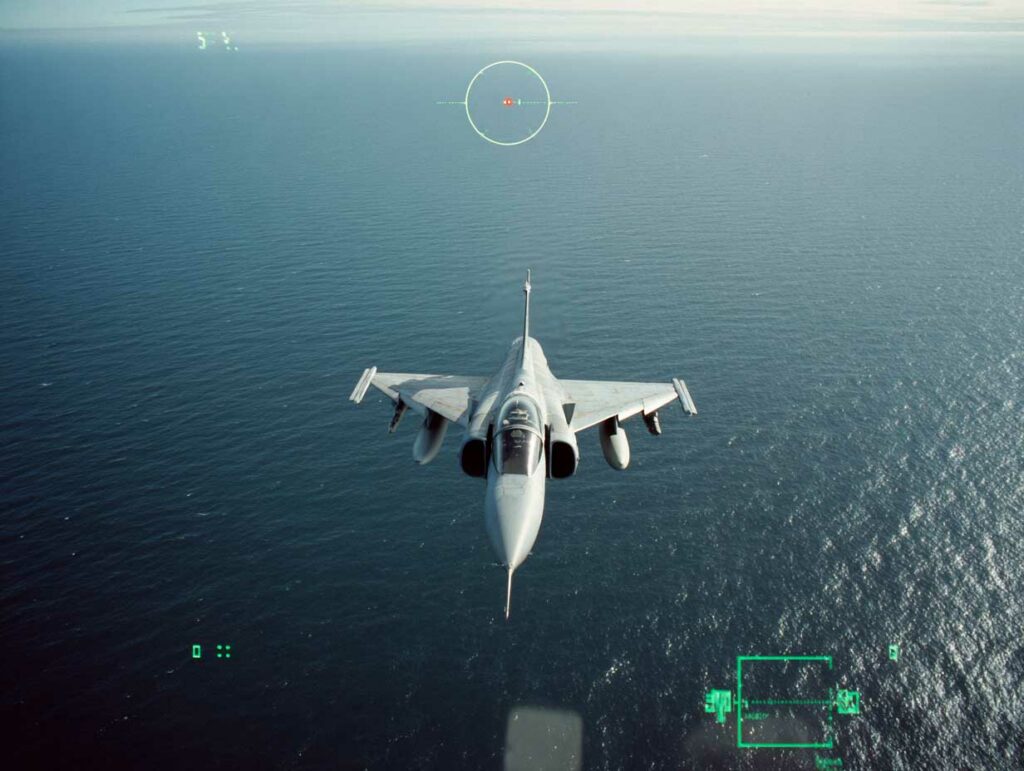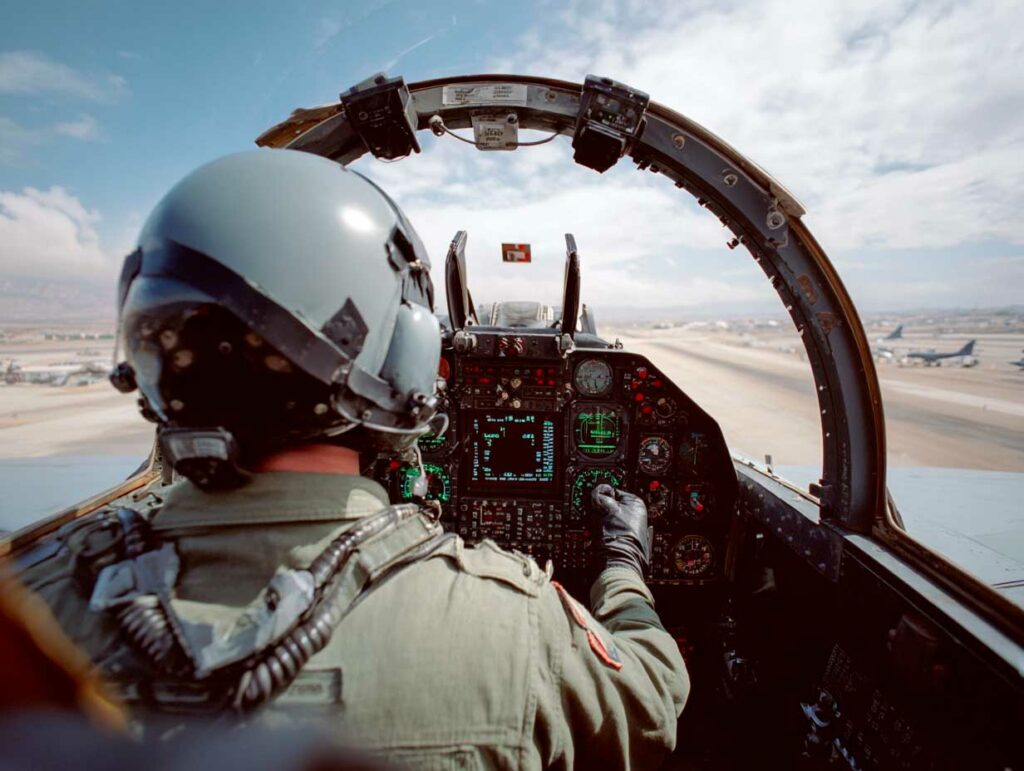
How do fighter jets identify friends and foes in an environment saturated with jamming? Technical analysis of modern IFF systems in combat.
Identifying friendly or enemy aircraft is a critical parameter in air combat, particularly in environments saturated with electronic warfare. For a fighter pilot, engaging a target without confirmation of identity can lead to friendly fire or delayed firing with a major operational impact. The identification friend or foe (IFF) system is designed to provide this confirmation by transmitting a coded signal that is interrogated by the onboard systems of a fighter aircraft. In a stable electromagnetic environment, this procedure is seamless. But when facing an adversary equipped with jammers, signal interceptors, or even falsified IFF systems, the reliability of the protocol becomes a direct tactical vulnerability.
Recent years have seen an intensification of electronic warfare in theaters such as Ukraine, the South China Sea, and the Levant. Western, Russian, and Chinese pilots operate in active jamming bubbles, where tactical links, radars, and IFF transponders can be partially or completely blinded. Under these conditions, technology alone is no longer enough. The entire friend-or-foe identification process must be redefined, multi-sensor verification methods must be integrated, and operating procedures compatible with loss of connectivity must be developed.
This article examines in detail current IFF systems, their limitations in electronic warfare, the doctrinal responses implemented, and the implications for pilot safety and the effectiveness of air operations.

An IFF system based on active and coded transponders
Friendly-enemy identification has historically relied on an exchange of signals between an interrogator and a transponder. The interrogator, usually carried on an aircraft, ground radar station, or ship, transmits a coded pulse in a given mode (mode 1, 2, 3/A, C, 4, or 5). The transponder on the interrogated aircraft responds with a return signal that is also coded, which the interrogator identifies as friend or unknown.
Secure military modes, such as Mode 4 (a legacy of the Cold War) or Mode 5 (current), use dynamic encryption and frequency hopping algorithms, reducing the likelihood of signal interception or spoofing. Mode 5, used by NATO forces and their partners, operates at 512 bits, with automatic authentication and anti-replay protection.
A modern fighter jet, such as the F-16 Block 70, Rafale F4 or F-35A, carries a latest-generation IFF system integrated into its radar, often via an AESA antenna. The system can operate in coupled mode, passively detecting enemy IFF signals without transmitting, or in active mode to formally identify a target.
However, IFF transponders must be synchronized with daily encryption keys, transmitted via a secure channel before each mission. A loading error or desynchronization can render a friendly aircraft unidentifiable, resulting in exclusion from operations or, in the worst case, an attempted friendly fire incident.
In modern environments, the volume of aircraft involved in a mission (aircraft, drones, guided missiles) makes code management more complex. The exchange frequency, identification resolution and sensitivity to jamming are all factors that must be taken into account in operational conduct.
A structural vulnerability in dense electronic warfare
Despite its advances, the IFF system remains vulnerable to interception, jamming, and electromagnetic saturation. In highly contested environments, such as high-intensity conflict zones, opposing forces deploy electronic warfare capabilities capable of blinding IFF systems or even manipulating them.
Active jammers, such as the Russian Krasukha-4 or the Chinese JY-300 pods, transmit signals on the frequency bands used by IFF transponders (generally around 1 GHz), making it impossible to reliably detect a friendly response. In the absence of a signal or in the event of an erroneous response, a fighter pilot must suspend firing or use alternative means of confirmation.
Some threats go even further. Spoofing techniques can simulate a friendly signal by reproducing the structure of a valid code without possessing the key. This type of attack remains theoretically limited to major technological powers, but its mere possibility requires the strengthening of verification chains.
Jamming not only affects the IFF response, but also tactical data links, such as Link 16, which enable identification to be shared within a group of aircraft. When an aircraft loses its ability to communicate, it becomes a blind spot in the system, requiring increased caution from its teammates.
Faced with this reality, some operating doctrines recommend reducing the active use of IFF in contested areas in favor of passive modes or radar-visual correlation. Cross-identification through kinematic analysis, flight profile, or radar emission type allows the nature of a target to be assessed, but without absolute certainty.
Finally, in asymmetric conflicts, the proliferation of commercial drones, some of which have been modified, renders IFF filtering obsolete. These drones do not carry transponders, do not comply with any standards, and are only detectable by visual or thermal observation. This broadens the spectrum of unidentifiable threats.

A tactical response based on multi-sensor fusion and artificial intelligence
To overcome the limitations of the IFF system in the context of electronic warfare, modern air forces are developing multi-sensor data fusion systems coupled with behavioral analysis algorithms. This approach aims to validate the identity of a target from several correlated sources, without relying on a single transponder.
A fighter jet such as the F-35A is equipped with IRST (Infrared Search and Track) sensors, passive EM sensors, AESA electronic scanning radars, and encrypted data links. These systems, cross-referenced in real time by the centralized mission system, make it possible to identify an aircraft by its thermal signature, radar profile, maneuvers, or flight behavior.
For example, an aircraft flying in standard formation, on a known route, at a speed compatible with an allied type, and transmitting on a coded frequency, will be much more likely to be identified as friendly than an isolated aircraft flying in the opposite direction. The analysis is performed in a matter of seconds by onboard processors, with visual feedback for the pilot.
Artificial intelligence is also integrated into these processing chains. It is used to classify targets according to confidence levels and alert the pilot in the event of an anomaly. These systems do not make the decision to fire, but assist in the decision-making process by highlighting probable threats or inconsistencies.
At the same time, operating doctrines are evolving. Some forces impose automatic no-fly zones, where any unidentified aircraft is considered hostile. Others favor short-range visual reconnaissance, which imposes additional risks on fighter pilots.
Finally, innovations in future IFF include quantum technologies, encryption protocols that are impossible to copy, and directional signals limited to pairs of transceivers. These solutions are still in the experimental stage, but could redefine identification security in contested areas by 2030.
War Wings Daily is an independant magazine.